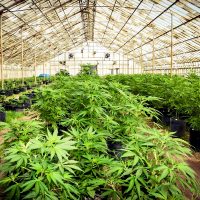Legal marijuana sales creating escalating damage to the environment
February 20, 2017

The business of growing marijuana has a negative impact on the environment, as cultivation requires significant amounts of water and energy and causes air pollution.
Marijuana sales have created an economic boom in states that have fully or partially relaxed their cannabis laws, but is the increased cultivation and sale of this crop also creating escalating environmental damage and a threat to public health?
In a recent opinion piece appearing in the journal Environmental Science and Technology, researchers from the University of North Carolina at Chapel Hill and Lancaster University in the U.K. have called on U.S. federal agencies to fund studies that will gather essential environmental data from the legal cultivation farms and facilities. These data can then be used to help states minimize any environmental and public health damage caused by this burgeoning industry and aid legal marijuana growers in making their business environmentally sustainable.
State-by-state legalization is effectively creating a new industry in the U.S., one that looks set to rival all but the largest of current businesses. In Colorado alone, sales revenues have reached $1 billion, roughly equal to that from grain farming in the state. By 2020, it is estimated that country-wide legal marijuana sales will generate more annual revenue than will the National Football League.
However, the article, titled “High Time to Assess the Environmental Impacts of Cannabis Cultivation” and co-authored by William Vizuete, PhD, associate professor of environment sciences and engineering at UNC’s Gillings School of Global Public Health, and Kirsti Ashworth, PhD, research fellow at Lancaster University’s Lancaster Environment Centre, says that this expanded cultivation carries with it serious environmental effects.
Vizuete and Ashworth point out that cannabis is an especially needy crop, requiring high temperatures (25°-30°C for indoor operations), strong light, highly fertile soil and large volumes of water – around twice that of wine grapes. In addition, the authors state that the few available studies of marijuana cultivation have uncovered potentially significant environmental impacts due to excessive water and energy demands and local contamination of water, air and soil.
For example, a study of illegal outdoor growing operations in northern California found that rates of water extraction from streams threatened aquatic ecosystems. High levels of growth nutrients, as well as pesticides, herbicides and fungicides, also found their way back into the local environment, further damaging aquatic wildlife. Moreover, controlling the indoor growing environment requires considerable energy, with power requirements estimated to be similar to that of Google’s massive data centers. There also have been no significant data collected on the impact of air pollution on workers’ health inside these growing facilities or the degradation of outdoor air quality due to emissions produced by the industrial-scale production of marijuana.
The authors emphasize that much of the data on marijuana cultivation to date has come from monitoring illegal cannabis-growing operations.
“The illegal status of marijuana has prevented us from understanding the detrimental impacts that this industrial scale operation has on the environment and public health,” they said. “This is an industry undergoing historic transition, presenting an historic opportunity to be identified as a progressive, world-leading example of good practice and environmental stewardship.”
The continued expansion of legalization by the states does offer significant opportunities for the U.S. Department of Agriculture, Environmental Protection Agency, National Institutes of Health, and Occupational Safety and Health Administration to fund research into legal cannabis cultivation to protect the environment.
“Generating accurate data in all the areas we discussed offers significant potential to reduce energy consumption and environmental harm, protect public health and ultimately, improve cultivation methods,” Vizuete said. “There are also significant potential public health issues caused by emissions from the plants themselves rather than smoking it. These emissions cause both indoor and outdoor air pollution.”
Vizuete added that this is a specific issue he and his collaborators are studying.
The full piece can be found here.
Gillings School of Global Public Health contact: David Pesci, director of communications, (919) 962-2600 or dpesci@unc.edu

